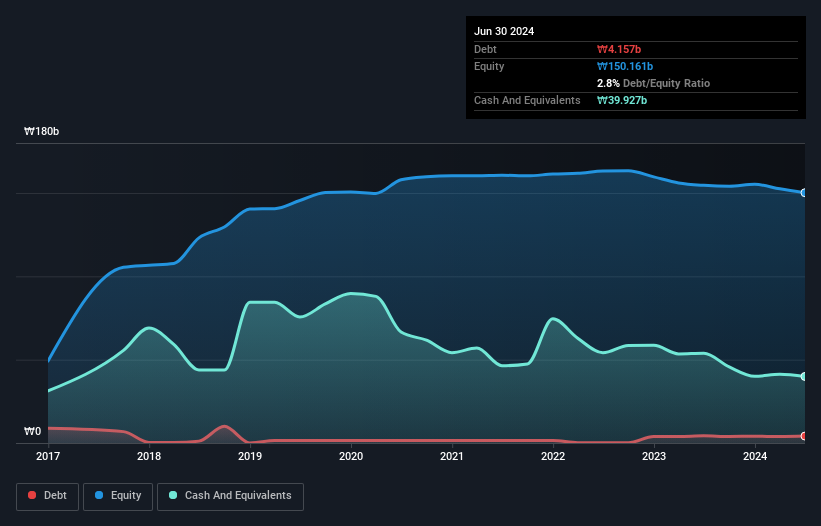David Iben put it well when he said, 'Volatility is not a risk we care about. What we care about is avoiding the permanent loss of capital.' When we think about how risky a company is, we always like to look at its use of debt, since debt overload can lead to ruin. We can see that YAS Co., Ltd. (KOSDAQ:255440) does use debt in its business. But is this debt a concern to shareholders?
What Risk Does Debt Bring?
Debt assists a business until the business has trouble paying it off, either with new capital or with free cash flow. Ultimately, if the company can't fulfill its legal obligations to repay debt, shareholders could walk away with nothing. While that is not too common, we often do see indebted companies permanently diluting shareholders because lenders force them to raise capital at a distressed price. Of course, the upside of debt is that it often represents cheap capital, especially when it replaces dilution in a company with the ability to reinvest at high rates of return. When we think about a company's use of debt, we first look at cash and debt together.
Check out our latest analysis for YAS
What Is YAS's Debt?
The chart below, which you can click on for greater detail, shows that YAS had ₩4.16b in debt in June 2024; about the same as the year before. However, it does have ₩39.9b in cash offsetting this, leading to net cash of ₩35.8b.

A Look At YAS' Liabilities
We can see from the most recent balance sheet that YAS had liabilities of ₩39.3b falling due within a year, and liabilities of ₩7.29b due beyond that. On the other hand, it had cash of ₩39.9b and ₩9.13b worth of receivables due within a year. So it actually has ₩2.47b more liquid assets than total liabilities.
This short term liquidity is a sign that YAS could probably pay off its debt with ease, as its balance sheet is far from stretched. Succinctly put, YAS boasts net cash, so it's fair to say it does not have a heavy debt load! When analysing debt levels, the balance sheet is the obvious place to start. But you can't view debt in total isolation; since YAS will need earnings to service that debt. So when considering debt, it's definitely worth looking at the earnings trend. Click here for an interactive snapshot.
In the last year YAS had a loss before interest and tax, and actually shrunk its revenue by 18%, to ₩37b. We would much prefer see growth.
So How Risky Is YAS?
We have no doubt that loss making companies are, in general, riskier than profitable ones. And we do note that YAS had an earnings before interest and tax (EBIT) loss, over the last year. Indeed, in that time it burnt through ₩14b of cash and made a loss of ₩4.0b. While this does make the company a bit risky, it's important to remember it has net cash of ₩35.8b. That kitty means the company can keep spending for growth for at least two years, at current rates. Overall, its balance sheet doesn't seem overly risky, at the moment, but we're always cautious until we see the positive free cash flow. The balance sheet is clearly the area to focus on when you are analysing debt. But ultimately, every company can contain risks that exist outside of the balance sheet. These risks can be hard to spot. Every company has them, and we've spotted 2 warning signs for YAS (of which 1 makes us a bit uncomfortable!) you should know about.
If you're interested in investing in businesses that can grow profits without the burden of debt, then check out this free list of growing businesses that have net cash on the balance sheet.
New: Manage All Your Stock Portfolios in One Place
We've created the ultimate portfolio companion for stock investors, and it's free.
• Connect an unlimited number of Portfolios and see your total in one currency
• Be alerted to new Warning Signs or Risks via email or mobile
• Track the Fair Value of your stocks
Have feedback on this article? Concerned about the content? Get in touch with us directly. Alternatively, email editorial-team (at) simplywallst.com.
This article by Simply Wall St is general in nature. We provide commentary based on historical data and analyst forecasts only using an unbiased methodology and our articles are not intended to be financial advice. It does not constitute a recommendation to buy or sell any stock, and does not take account of your objectives, or your financial situation. We aim to bring you long-term focused analysis driven by fundamental data. Note that our analysis may not factor in the latest price-sensitive company announcements or qualitative material. Simply Wall St has no position in any stocks mentioned.
About KOSDAQ:A255440
YAS
Engages in the manufacture and sale of OLED process equipment for use in OLED TVs, OLED lighting products, solar cells, and others in South Korea.
Mediocre balance sheet with very low risk.
Similar Companies
Market Insights
Community Narratives



